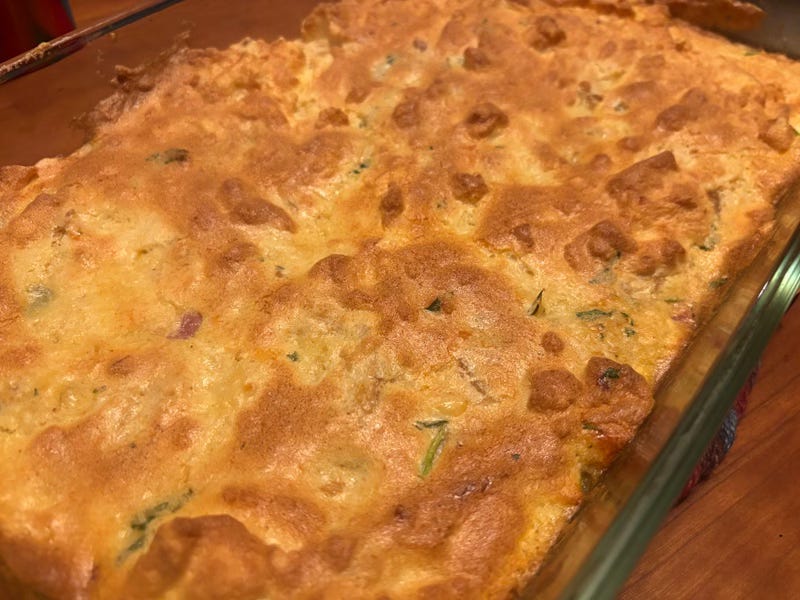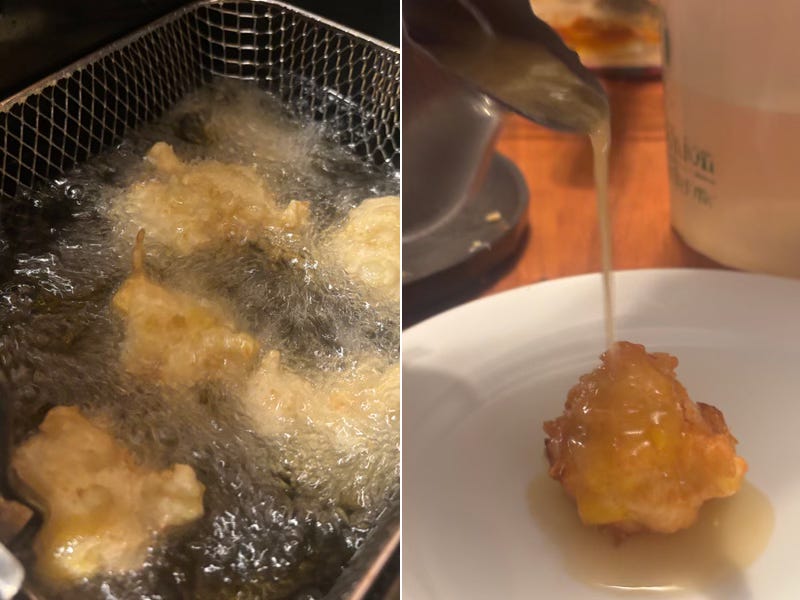THE COOKBOOK TEST #0070: CHARLESTON RECEIPTS
INSTALLMENT #0070 (PAID) OLDER THAN OLD / I KEEP ALL MY RHYMES IN MY LE SPORTSAC / NON-STARTERS / CHEESE PUFFIT / PINEAPPLE FRITTERS
Dear Subscribers,
I remember reading recently about the discovery of a museum of antiquities maintained by the daughter of a Babylonian king in 530 BC. The room, complete with museum labels in three languages, makes total sense - of course people 2,500 years ago were also collecting and interpreting old things, just as we do.
But it's also a little bit mind-blowing, the sort of thing that can cause you to fall into a recursive, "where does it all end / what does it all mean?" sort of trance state.
Reading CHARLESTON RECEIPTS had a similar, if less grandiose, impact on me. This is a book written in 1950 to collect traditional and increasingly bygone Southern recipes from the Charleston, South Carolina area. So, yes, it's a historically-minded preservation of old lore. But it's also a historically-minded preservation of old lore that is, by itself, already 75 years old.
Throw in the additional lens of "I am a Wisconsin/Minnesota guy with some familiarity with Boston and New York," and I am not the target readership for this book in a whole variety of ways. Need I add that this made the book that much more fun to read and cook from?
at your service,
James
CHARLESTON RECEIPTS
COLLECTED BY THE JUNIOR LEAGUE OF CHARLESTON
WALTER, EVANS & COGSWELL CO. | 1950 | $2.75 PLUS .20 MAILING CHARGES
"Why receipts?" you might ask. The book itself helpfully answers us... with a song! Well, not actually a song, but definitely a verse that could be set to music if we felt so inclined:
Throughout the book, as you will see,
We never mention recipe -
The reason being that we felt,
(Though well aware of how it is spelt!),
That it is modern and not meet
To use in place of old receipt
To designate time-honored dishes
According to ancestral wishes.
I love this shit!! It's simultaneously corny and amazing to make up a bunch of little poems and scatter them will-nilly across your cookbook. Will I do this when I inevitably publish my family's sacred tome of cookery? I might! And it may just be that our poems will be spoken in the voices of various historical cats from the Dilley-Norton household. Brace yourself!
Here's another poem to get you going:
Ratifia is a drink
That ought to make you pause and think.
The drink is thimble-sized, it's true,
But what that thimble does to you ! ! !
Remember, e'er you grow too bold,
That David knocked Goliath cold!
You know what? I'm going to come right out and say it: This verse is not bad at all.
NON-STARTERS
When I was surfing through Charleston Receipts to find a couple of things to cook, I encountered a number of recipes that I had to chuck out the window almost immediately. This wasn't really a bad thing - it was reflective of the book being phoned in from a very different time and a very different place. I'm going to provide a few examples to illustrate my thesis.
In the dessert section, we find "MRS. COLCOCK'S MINCE MEAT." Good start. Ambiguously sexy. And if memory serves, "mincemeat" is actually a sweet, fruity sort of holiday baked good filling.
Ingredient #1: "1 Beef Tongue."
Really?! An entire beef tongue? Have you seen cows, recently? They're large!
From there, we get raisins, citron (1 pound), beef suet (2 pounds!), a quart of wine, a pint of whiskey, a dozen apples... well, clearly this is a) mincemeat on an industrial scale and b) mincemeat from days gone by. What with the not-that-many-beef tongues-around-these-days of it all. [1]
And if you're wondering what the average beef tongue weighs, the not-entirely-reliable Internet suggests about 2-3 pounds.
OK, so, that's not a totally practical direction. How about "TUTTI-FRUTTI SAUCE"? Sounds nice. Great for kids! Ingredient #1: "1 quart grain alcohol."
I LOVE IT. As a Wisconsinite, I respond well to any reference to grain alcohol, it just doesn't mess around. [2] But back to the sauce: combine your grain alcohol (as you do) with 1 cup of fresh fruit and 1 cup of sugar, and cover it in a 1 gallon crock. "Begin in March..." Begin in March? Begin in a specific month! Now THIS is a vintage recipe.
"Start first with pineapple and then use your own ingenuity in procuring a variety of fruits and berries." There are so many things I love about this sentence.
It goes on: "In November"... Eight months later! "In November add 1 cup seeded raisins and 1 cup broken pecan meats. Stir after addition of fruit with wooden spoon. This is ready for Christmas."
Mrs. Andrew J. Geer (Mary Owen), I thank you for your service. This is an amazing recipe, and if I can remember in March, I may even attempt it. Just unhinged.
On the savory side of things, "MRS. H.C. MAZYCK'S PARTRIDGE PIE" sounds promising. First ingredient: "12 partridges." To which I can only say: Even at Costco, that is not how partridges are dispensed these days. Which is to say, I have never seen or eaten a partridge and am only familiar with them thanks to Christmas carols. But if you don't have partridges, do not fear: You may substitute doves or snipe.
You can tell that "HOG'S HEAD CHEESE" is gonna be trouble, but even I was not ready for ingredient #1: "1/2 hog's head." That's right! Get half a hog's head, something that may not have been a large challenge in Charleston circa 1900 but is definitely a bit of a stumper in the modern Wal-Mart/Trader Joe's economy. "Have butcher clean hog's head. Boil the head in water to cover until meat falls of the bones. Mince the hog's head fine, removing all small bones."
Eventually, after the addition of salt, hot sauce, allspice, and vinegar, you get a thin pudding that you can pour into molds that firms up into "a jelly which can be sliced." I'm not saying I wouldn't try it, but this is not at the top of my current list of aspirational recipes.
The "'CAROLINA HOUSEWIFE' WEDDING CAKE OF 1850!" (exclamation point printed in the book) wouldn't be noteworthy except for the quantities.
20 pounds butter
20 pounds sugar
20 pounds flour
20 pounds raisins
40 pounds currants
12 pounds citron
20 nutmegs
1 ounce mace
4 ounces cinnamon
20 glasses wine
20 glasses brandy
10 eggs to the pound (pound of what?! does this mean 200 eggs?! -- JN)
Complete baking instructions are: "Add cloves to your taste." So... good luck.
You gotta love "THE BLUFF PLANTATION COOTER PIE" because, well, reasons. First ingredient: "1 medium sized cooter."
Yes. Anyhow. If you're feeling stumped in your cooter hunt, remember that "cooter" is just a regionalism for "terrapin," or freshwater turtle.
For this example, I'll also offer the first instruction of the recipe:
"Drop live cooter in the pot of boiling water."
HOLY ORIGINAL JAPANESE-LANGUAGE IRON CHEF, this is ABSOLUTELY TOO MUCH. [3]
Pass on this one! Skip! Pass, please!
CHEESE PUFFIT
Don't call it a souffle! It's a Puffit! This ... puffy ... thing... combines all the appeal of ham sauteed in butter with the ethereal fluffiness of stiffly beaten egg whites baked into a savory meringue. This is to say: It's quite appealing. As a brunch treat or even an offbeat weeknight dinner, it would be an unqualified success.
A couple of production notes: The original recipe called for lard. I substituted butter, because a) I have butter and b) I like butter. At no point did the presence of butter offend or annoy me, so I think that it's a good substitution.
I cooked my Puffit in a large baking pan and regretted it, a little - I think in a high-walled pie plate, it would have risen more and looked more dramatic and interesting. I should add that my final result was really tasty and inviting looking, so pick your own preference on this one. The eggs rise somewhat, but not to a ridiculous degree.
CHEESE PUFFIT
Mrs. Arthur Stoney (Anne Montague)
1 cup cooked ham, minced finely
1 Tbsp onion, chopped finely
2 Tbsp butter
2 slices soft bread (1/2" thick)
4 oz. mild cheddar, roughly shredded
2 eggs, separated - beat egg yolks
1/4 tsp paprika
1/2 tsp salt
1 1/3 Cups hot milk
1 Tbsp butter (additional)
1 Tbsp parsley, minced
Preheat oven to 325 F.
Sauté your ham and onion with 2 Tbsp butter and spread across the bottom of a greased baking dish - a deep-sided pie plate would be ideal.
Crumble bread (including crust) into small pieces, and combine in bowl with cheddar, egg yolks, and heated milk. Add extra tablespoon of butter, salt, and paprika. Stir and let stand 20 minutes.
Whip egg whites to stiff peaks. Add parsley to bread and cheese mixture, then fold in egg whites. Pour into baking dish over ham. Bake 40-50 minutes, until knife inserted into center comes out clean.
PINEAPPLE FRITTERS
I found the book's recipe for Pineapple Fritters to be irresistible. Pineapple is great, the recipe cites a famous hotel, and the fritters are served with a tasty pineapple sauce. Plus: Yet another chance to use what has become my absolute favorite kitchen appliance, the deep fryer.
But ultimately, the final product was ... acceptable. The fritters puffed up beautifully and weren't terribly sweet (which, honestly, is ideal) but the accompanying sauce was a little bit thin and was insufficiently rich. Something closer to a doughnut glaze or creme anglaise would have brought these fritters up to the level of "fancy dessert!" - as it is, they taste good, but a little bit underpowered and half-finished.
I'm including the recipe below not so much as an endorsement of the dish, but as a suggestion that could be built upon.
PINEAPPLE FRITTERS
Mrs. Eugene Geer (Winifred Williams)
The book notes: "These pineapple fritters are a specialty at the old Caesar's Head Hotel, Caesar's Head, South Carolina, where many Charlestonians summer."
1 egg
1 cup milk (scant)
3 Tbsp sugar
2 1/2 tsp baking powder
2 Tbsp butter, melted
2 1/2 cups flour to make stiff batter
1 cup crushed and drained pineapple
Combine in order given. Drop a tablespoonful at a time into 350 F degree fat in a deep fryer or cast iron pan. Fry for 4-6 minutes, turning halfway through, until golden brown.
SAUCE FOR PINEAPPLE FRITTERS
1 cup brown sugar
2 Tbsp flour
1 cup water
1 cup pineapple juice
2 Tbsp butter
juice from 1/2 lemon
Combine and cook until clear.
[1] FOOTNOTE: When I started going to taquerias with my then 5-year-old son, we found, much to my delight, that his favorite tacos were Lengua. Which is to say: beef tongue. They're actually not bad at all, in contrast to tripa (tripe), which I've never been able to get into.
[2] FOOTNOTE: Many Febgivings ago, my old Chef Camp partner, Dave, challenged me to do a shot of Wisconsin-strength [4] Everclear with him. I did. I regretted it.
[3] FOOTNOTE: I remember when I started watching Iron Chef in Cambridge, Mass. circa 2000/2001. There was an episode (Pike Eel, I think) where one of the chefs pounded a metal stake through the head of a live eel, which - as you might expect - reacted poorly. One of the most horrible things I've seen on television, but also incredibly compelling cooking content.
[4] FOOTNOTE: Wisconsin-strength Everclear is 190 proof. I believe Minnesota-strength still tops out at 150.






First, this review made me laugh out loud. Second, my mom emailed me within 15 minutes of its posting to tell me that she has a copy of this very cookbook, should I like to have it. Delightful.